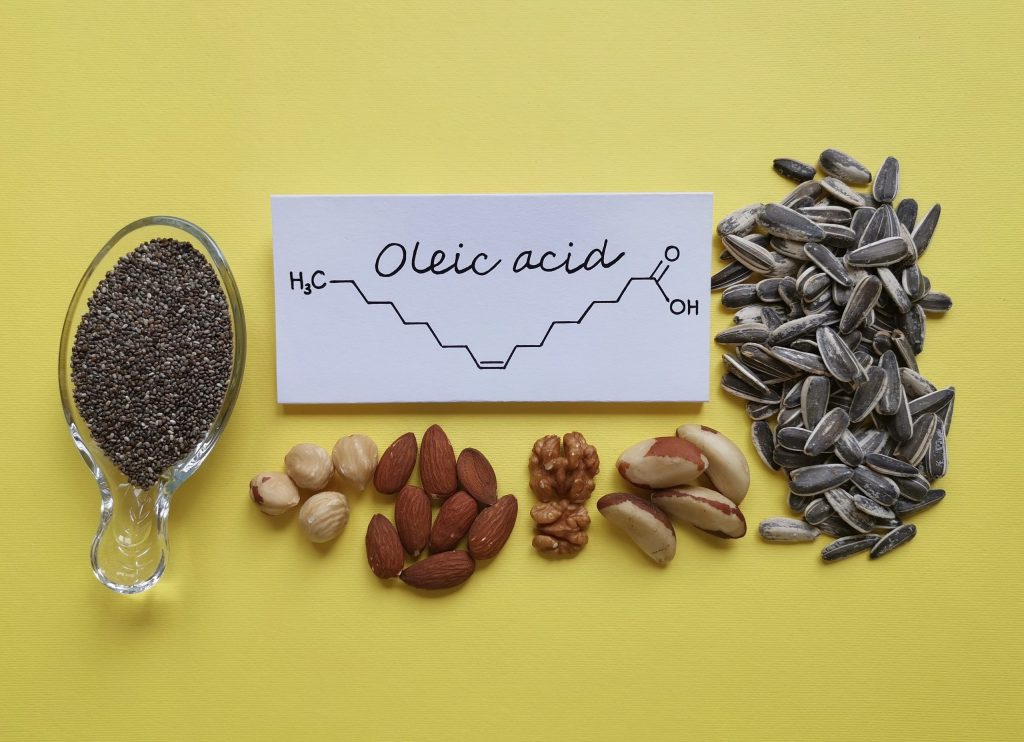Oleic acid In the cosmetics, food Industry, pharmaceuticals industrie, and even in soap-making, oleic acid proves to be an invaluable component due to its diverse applications.
Oleic acid, is a common type of fat found in nature, known for its many uses. Its scientific name is C18H34O2, and it’s made up of a long chain of 18 carbon atoms. Between the 9th and 10th carbon atom, there’s a double bond, which gives this product some special traits. You can find this fat in a lot of different animal and plant fats and oils, but it’s mostly known for being in olive oil.
Properties: it looks like a clear to light yellow liquid and has a faint smell when it’s at room temperature. It doesn’t mix with water, but it does mix well with things like alcohol and other similar liquids. One neat thing about this product is that it doesn’t break down easily, so it can be stored for a long time. That’s why it’s useful in a lot of industries. It starts to melt at about 13–14 °C, and it begins to boil around 360 °C. It’s also a weak acid, meaning it can give away tiny parts called protons when it’s in a basic solution.
From enhancing the nutritional value in the food industry, enriching the effectiveness of cosmetics, aiding medication in pharmaceuticals, to ensuring the cleanliness in soaps, oleic acid serves a crucial role in each of these domains. Whether it’s adding moisturizing properties to cosmetics product, enhancing the taste and health benefits of foods, improving the delivery of medicine in pharmaceuticals, or providing the cleansing power in soaps, oleic acid showcases its diverse applications and indispensability across multiple industries.
Applications of Oleic Acid
Oleic acid, a versatile ingredient, is widely used in various industries, such as the cosmetics sector for skincare products, the food industry due to its health benefits, pharmaceuticals for medication delivery, and in the production of soaps for its effective cleansing properties.
Food Industry: Which is found a lot in olive oil, is often part of our meals. Studies show that eating lots of it may help lower the bad cholesterol and raise the good cholesterol in our bodies. This can help lower the risk of heart disease.
Cosmetics and Personal Care: In the world of beauty, it helps mix things together in creams and lotions. Plus, it helps keep skin moist, making it a key part of skincare products.
Pharmaceuticals: In medicine, it helps drugs get through the skin. This is really important for patches and creams that need to deliver medicine directly through the skin.
Textiles: In the cloth-making business, it helps soften fibers, making fabrics softer.
Lubricants: helps things move smoothly and guards against rust. commonly used in synthetic oils because it can stand heat and doesn’t wear out easily.
Detergents and Soaps: In soap-making, it can mix with certain metals to create ‘soaps’. These help get rid of dirt and oils from different surfaces.
Chemical Industry: it is used to create other substances, so like agents that help mix oil and water, materials that make plastics flexible, and ingredients that help mix things together. It’s a stepping stone to creating these and other chemicals.

Future Prospects and Sustainability
As we keep growing and coming up with new ideas, it will become even more important. People are now more interested in things that are good for the planet, and it can help with this. It’s a resource that we can keep using over and over again, which makes it a great choice for a greener future.
Biofuel Production: it can be used to make biofuels. It’s a type of material that can be turned into biodiesel, helping meet the world’s growing need for clean energy. Oils from plants high in oleic acid work better and are more stable than regular biodiesel, so we wouldn’t need as much fossil fuel.
Biodegradable Plastics: In the world of plastics, oleic acid can be used to make biodegradable plastics. These new types of plastics, based on oleic acid, are a greener alternative to regular plastics. They’re also biodegradable and less harmful.
Nanotechnology: In nanotechnology, oleic acid helps stabilize tiny particles and can change the properties of these materials. For example, iron oxide nanoparticles coated with oleic acid are used in medicine for drug delivery and in MRI scans.
Agriculture: In farming, oleic acid is used in some bug killers and can help control some plant diseases. As farmers focus more on eco-friendly methods, we’ll likely use more oleic acid in the future.
Nutraceuticals: Oleic acid can also help improve our health, so it’s being used more in dietary supplements. These products aim to provide health benefits beyond just nutrition, contributing to better health and helping prevent diseases.
Conclusion
Oleic acid is not just a simple fat; it’s a super star in many fields because of its special traits. It’s important in our food, helping our health by being a good kind of fat. At the same time, it’s used in many businesses for lots of different things. It’s in skin creams, cleaning products, oiling tools, and even life-saving drugs. Oleic acid has many uses, showing how valuable it is in our daily lives. As we learn more and create new technologies, we will find even more uses for oleic acid.
